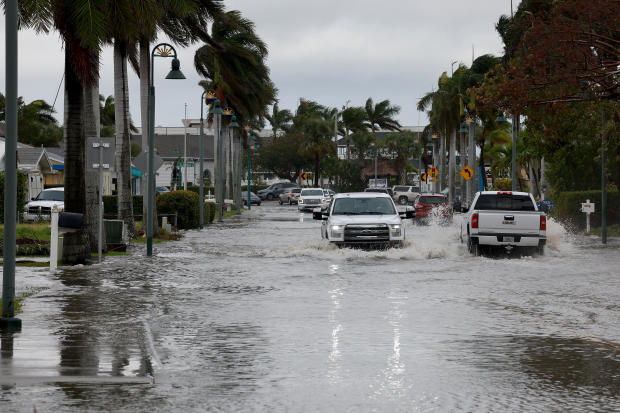Hurricane Nicole made landfall early Thursday along the east coast of Florida just south of Vero Beach, the National Hurricane Center said, before quickly losing some punch and being downgraded to a tropical storm as it moved over central Florida. But it was still hitting a large area of the storm-weary state with strong winds, dangerous storm surge and heavy rain, the center said.
What was a rare November hurricane had already led officials to shut down airports and theme parks and order evacuations that included former President Donald Trump’s Mar-a-Lago club.
Authorities warned that Nicole’s storm surge could further erode many beaches hit by Hurricane Ian in September.
And the number of power outages kept growing: Some 363,000 homes and businesses in Florida had no electricity, according to PowerOutage.us.
Nicole had maximum sustained winds of 50 mph Thursday morning with its center about 30 miles northeast of Tampa and about 60 miles west-southwest of Orlando, according to the hurricane center. It was moving west-northwest at 16 mph.
Joe Raedle/Getty Images
Tropical storm force winds from the sprawling storm extended as far as 345 miles from the center in some directions.
Nicole was expected to move west toward the Gulf of Mexico on Thursday, shift north and then move across the Florida Panhandle and parts of Georgia on Thursday night, the hurricane center said. The storm was expected to move through the southeastern U.S. on Friday.
Mike’s Weather Page tweeted videos of many dramatic scenes, including these:
Nicole became a hurricane Wednesday evening as it slammed into Grand Bahama Island after making landfall just hours earlier on Great Abaco island as a tropical storm with maximum sustained winds of 70 mph. It’s the first storm to hit the Bahamas since Hurricane Dorian, a Category 5 storm that devastated the archipelago in 2019.
For storm-weary Floridians, it’s only the third November hurricane to hit their shores since recordkeeping began in 1853. The previous ones were the 1935 Yankee Hurricane and Hurricane Kate in 1985.
Mar-a-Lago, Trump’s club and home, was in one of the evacuation zones, about a quarter-mile inland from the ocean. The main buildings sit on a small rise about 15 feet above sea level, and the property has survived numerous stronger hurricanes since it was built nearly a century ago. The resort’s security office hung up Wednesday when an Associated Press reporter asked whether the club was being evacuated. There was no sign of evacuation by Wednesday afternoon.
There’s no penalty for ignoring an evacuation order, but rescue crews won’t respond if it puts their members at risk.
Officials in Daytona Beach Shores deemed unsafe at least a half dozen, multi-story, coastal residential buildings already damaged by Hurricane Ian and now threatened by Nicole. At some locations, authorities went door-to-door telling people to grab their possessions and leave.
Disney World and Universal Orlando Resort shut down Wednesday but said they intend to reopen Thursday, according to the Orlando Sentinel.
Palm Beach International Airport closed Wednesday morning and Daytona Beach International Airport said it would suspend operations. Orlando International Airport, the seventh busiest in the U.S., also closed. Farther south, officials said Fort Lauderdale-Hollywood International Airport and Miami International Airport experienced some flight delays and cancellations but both planned to remain open.
At a news conference in Tallahassee, Gov. Ron DeSantis said winds were the biggest concern and significant power outages could occur, but that 16,000 linemen were on standby to restore power as well as 600 guardsmen and seven search and rescue teams.
Nicole “will affect huge parts of the state of Florida all day,” DeSantis said.
Almost two dozen school districts were closing schools for the storm and 15 shelters were open along Florida’s east coast, the governor said.
Forty-five of Florida’s 67 counties were under an emergency declaration.
Warnings and watches were issued for many parts of Florida, including the southwestern Gulf coastline that was devastated by Hurricane Ian, which struck as a Category 4 storm Sept. 28. The storm destroyed homes and damaged crops, including orange groves, across the state – damage many are still dealing with.
Daniel Brown, a senior hurricane specialist at the Miami-based hurricane center, said the storm would affect a large swath of Florida.
“Because the system is so large, really almost the entire east coast of Florida except the extreme southeastern part and the Keys is going to receive tropical storm force winds,” he said.
Early Wednesday, President Biden declared an emergency in Florida and ordered federal assistance to supplement state, tribal and local response efforts to the approaching storm. The Federal Emergency Management Agency (FEMA) is still responding to people who need help in Hurricane Ian’s wake.
Ian brought storm surge of up to 13 feet in late September, causing widespread destruction.
